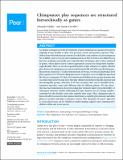Files in this item
Chimpanzee play sequences are structured hierarchically as games
Item metadata
| dc.contributor.author | Mielke, Alexander | |
| dc.contributor.author | Carvalho, Susana | |
| dc.date.accessioned | 2022-11-22T10:30:10Z | |
| dc.date.available | 2022-11-22T10:30:10Z | |
| dc.date.issued | 2022-11-16 | |
| dc.identifier | 282255930 | |
| dc.identifier | 218e6bfc-34a5-4640-9e18-fd996958b934 | |
| dc.identifier | 85141915634 | |
| dc.identifier | 000892580800001 | |
| dc.identifier.citation | Mielke , A & Carvalho , S 2022 , ' Chimpanzee play sequences are structured hierarchically as games ' , PeerJ , vol. 10 , e14294 . https://doi.org/10.7717/peerj.14294 | en |
| dc.identifier.issn | 2167-8359 | |
| dc.identifier.other | crossref: 10.7717/peerj.14294 | |
| dc.identifier.uri | https://hdl.handle.net/10023/26463 | |
| dc.description | Funding: This research was funded by the British Academy through Alexander Mielke's Newton International Fellowship. Alexander Mielke also received funding from the Leverhulme Trust. The long-term efforts to develop and support the research on wild chimpanzees, at the Bossou Field Station, in Guinea, were supported by grants from MEXT (#12002009, #16002001, #20002001, #24000001, #16H06283) and JSPS (Core-to-core CCSN and U04-PWS). | en |
| dc.description.abstract | Social play is ubiquitous in the development of many animal species and involves players adapting actions flexibly to their own previous actions and partner responses. Play differs from other behavioural contexts for which fine-scale analyses of action sequences are available, such as tool use and communication, in that its form is not defined by its function, making it potentially more unpredictable. In humans, play is often organised in games, where players know context-appropriate actions but string them together unpredictably. Here, we use the sequential nature of play elements to explore whether play elements in chimpanzees are structured hierarchically and follow predictable game-like patterns. Based on 5,711 play elements from 143 bouts, we extracted individual-level play sequences of 11 Western chimpanzees (Pan troglodytes verus) of different ages from the Bossou community. We detected transition probabilities between play elements that exceeded expected levels and show that play elements form hierarchically clustered and interchangeable groups, indicative of at least six games that can be identified from transition networks, some with different roles for different players. We also show that increased information about preceding play elements improved predictability of subsequent elements, further indicating that play elements are not strung together randomly but that flexible action rules underlie their usage. Thus, chimpanzee play is hierarchically structured in short games which limit acceptable play elements and allow players to predict and adapt to partners’ actions. This “grammar of action” approach to social interactions can be valuable in understanding cognitive and communicative abilities within and across species. | |
| dc.format.extent | 29 | |
| dc.format.extent | 388868 | |
| dc.language.iso | eng | |
| dc.relation.ispartof | PeerJ | en |
| dc.subject | Play | en |
| dc.subject | Chimpanzees | en |
| dc.subject | Pan troglodytes verus | en |
| dc.subject | Sequences | en |
| dc.subject | Action grammar | en |
| dc.subject | Games | en |
| dc.subject | RC0321 Neuroscience. Biological psychiatry. Neuropsychiatry | en |
| dc.subject | QL Zoology | en |
| dc.subject | DAS | en |
| dc.subject | MCC | en |
| dc.subject.lcc | RC0321 | en |
| dc.subject.lcc | QL | en |
| dc.title | Chimpanzee play sequences are structured hierarchically as games | en |
| dc.type | Journal article | en |
| dc.contributor.sponsor | The Leverhulme Trust | en |
| dc.contributor.institution | University of St Andrews. School of Psychology and Neuroscience | en |
| dc.identifier.doi | https://doi.org/10.7717/peerj.14294 | |
| dc.description.status | Peer reviewed | en |
| dc.identifier.grantnumber | ECF-2021-642 | en |
This item appears in the following Collection(s)
Items in the St Andrews Research Repository are protected by copyright, with all rights reserved, unless otherwise indicated.

